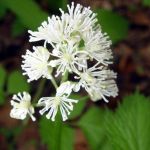| Common Name: |
Fetid Bugbane |
| Botanical Name: |
Actaea foetida syn. Cimicifuga foetida. |
| Genus: |
Actaea |
| Family: |
Ranunculaceae |
| Native Location: |
Siberia, E. Asia |
| Cultivation: |
Moist, rich, neutral to acid soil in partial shade. |
| Propagation: |
By seed sown when ripe in a cold frame or nursery bed for germination the following spring; by division in spring. |
| Harvest: |
Rhizomes are lifted in autumn and used fresh in tinctures, or used dried for use in decoctions, liquid extracts, and tinctures. |
| Height: |
1.2-2m (4-6ft) |
| Width: |
50-80cm (20-32in) |
| Hardiness: |
Z4-8 |
| Parts Used: |
Rhizomes (sheng ma) |
| Properties: |
An anti-infective herb that lowers fevers and relieves pain. |
| Medicinal Uses: |
Internally for coughs, colds, headaches, gum-disease, and feverish infections, such as measles. |
| Bibliography: |
Encyclopedia of herbs by Deni Brown Copyright © 1995, 2001 Dorling Kindersley Limited. pg 102 |

